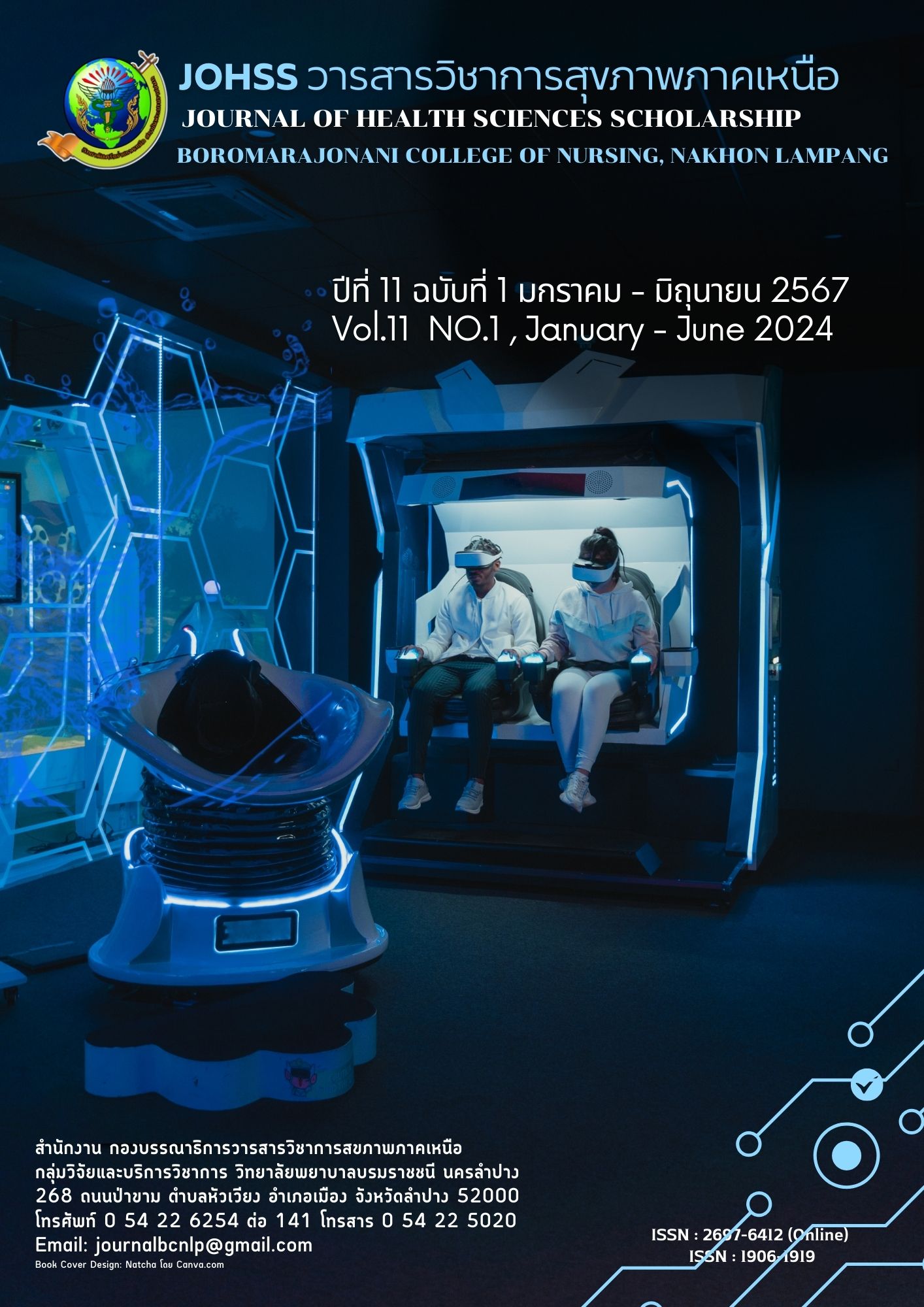การดูแลผู้ป่วยสมองบาดเจ็บชนิดไม่รุนแรง กับบทบาทพยาบาลฉุกเฉิน
บทคัดย่อ
บทความนี้มีวัตถุประสงค์เพื่อ 1) ให้ทราบถึงความสำคัญในการประเมินผู้ป่วยสมองบาดเจ็บ ชนิดไม่รุนแรง 2) แนวทางการดูแลผู้ป่วยสมองบาดเจ็บ ชนิดไม่รุนแรง ที่เข้ารับการรักษาในห้องฉุกเฉิน โดยมีการนำแนวคิดมาตรฐานการดูแลผู้ป่วยสมองบาดเจ็บมาเป็นแนวทางในการปฏิบัติสำหรับดูแลผู้ป่วยสมองบาดเจ็บ ชนิดไม่รุนแรง ที่ต้องได้รับการดูแลในห้องฉุกเฉิน เพื่อป้องกันการเกิดสมองบาดเจ็บในระยะทุติยภูมิ
การดูแลที่เป็นสาระสำคัญของการดูแลผู้ป่วยสมองบาดเจ็บ ชนิดไม่รุนแรง ที่เข้ารับการรักษาในห้องฉุกเฉิน ประกอบด้วย พยาธิสรีรวิทยาภายหลังเกิดการสมองบาดเจ็บ การจำแนกระดับความรุนแรง สมรรถนะและบทบาทของพยาบาลในการดูแลผู้ป่วยสมองบาดเจ็บ ชนิดไม่รุนแรง ได้แก่ การประเมินผู้ป่วย การเฝ้าระวังและการติดตามอาการเปลี่ยนแปลง การจัดการอาการทรุดลง การจำหน่ายผู้ป่วยออกจากห้องฉุกเฉิน เพื่อป้องกันและลดความเสี่ยงจากโอกาสเกิดภาวะแทรกซ้อนจากสมองบาดเจ็บในระยะทุติยภูมิได้อย่างเหมาะสม
เอกสารอ้างอิง
Al-Salihi, M. M., Ayyad, A., Al-Jebur, M. S., & Rahman, M. M. (2022). The "Talk and Die" phenomenon in traumatic brain injury: A meta-analysis. Clinical neurology and neurosurgery, 218, 107262.
American College of Surgeons. (2018). Advance Trauma Life Support: The tenth edition. (2018). Chicago: American College of Surgeons.
Binsa, F., Khupantavee, N & Naka, K. (2022). Effectiveness of discharge instruction on mobile application toward knowledge and care practice of caregivers of patients with low risk mild traumatic brain injury before discharge from emergency department. Princess of Naradhiwas University Journal, 15(1), 157-172. (in Thai)
Chanplakorn, P., Angsanuntsukh, C., Kulachote, N., Sa-ngasoongsong, P. & Kanchanathepsak, T. (2019). Orthopaedic trauma. Retrieved 6 December, 2023, from: https://www.rama.mahidol.ac.th/ortho/sites/default/files/public/education/textbook/pdf/OrthopaedicTrauma2019/00%20Content%20A-Z.pdf. (in Thai)
Department of dieases control. (2021). Annual report 2021. Retrieved 4 December, 2023, from:
https://ddc.moph.go.th/uploads/publish/1244420220310035829.pdf (in Thai)
Déry, J., Ouellet, B., de Guise, É., Bussières, È.-L., & Lamontagne, M.-E. (2023). Prognostic factors for persistent symptoms in adults with mild traumatic brain injury: an overview of systematic reviews. Systematic Reviews, 12(1), 127-142.
Dewan, M. C., Rattani, A., Gupta, S., Baticulon, R. E., Hung, Y. C., Punchak, M., Agrawal, A., Adeleye, A. O., Shrime, M. G., Rubiano, A. M., Rosenfeld, J. V., & Park, K. B. (2018). Estimating the global incidence of traumatic brain injury. Journal of neurosurgery, 1-18.
Dixon, J., Comstock, G., Whitfield, J., Richards, D., Burkholder, T. W., Leifer, N., . . . Calvello Hynes, E. J. (2020). Emergency department management of traumatic brain injuries: A resource tiered review. African journal of emergency medicine, 10(3), 159-166.
Ganz J. C. (2013). The lucid interval associated with epidural bleeding: evolving understanding. Journal of neurosurgery, 118(4), 739–745.
Jiamsakul, S & Prachusilpa, G. (2017). A study of nursing outcomes quality indicators for patients with neurosurgery. Journal of The Royal Thai Army Nurses, 18(Supplement), 147-154. (in Thai)
McGee, S. (2018). Chapter 19 - respiratory rate and abnormal breathing patterns. In S. McGee (Ed.), Evidence-Based Physical Diagnosis (Fourth Edition) (pp. 145-156.e144). Philadelphia: Elsevier.
Mckee, A. C., & Daneshvar, D. H. (2015). The neuropathology of traumatic brain injury. Handbook of clinical neurology, 127, 45–66.
Nee, P. A., Hadfield, J. M., Yates, D. W., & Faragher, E. B. (1999). Significance of vomiting after head injury. Journal of Neurology, Neurosurgery and Psychiatry. 66(4), 470-473.
Núñez-Patiño, R. A., Rubiano, A. M., & Godoy, D. A. (2020). Impact of cervical collars on intracranial pressure values in traumatic brain injury: A systematic review and meta-analysis of prospective studies. Neurocrit Care, 32(2), 469-477.
Panyangam, A., Sukonthasarn, A., Wangsrikhun, S. (2017). Effects of emergency department discharge planning for persons with mild traumatic brain injury on caregivers’ knowledge and practices. Nursing Journal, 44(1), 86-98. (in Thai)
Potaya, S. (2019). Prevention and risk reduction of secondary brain injury. EAU Heritage Journal Science and Technology, 13(3), 22-31.
Reith, F. C., Synnot, A., van den Brande, R., Gruen, R. L., & Maas, A. I. (2017). Factors influencing the reliability of the Glasgow Coma Scale: A systematic review. Neurosurgery. 80(6), 829-839.
Rooplor, S., Leethong-in, L., Piyawattanapong, S. (2021). Effects of the self-efficacy enhancing program on the practice behavior of caregivers for the older patients with mild traumatic brain injury after discharge and post-concussion syndrome. Srinagarind Med J, 36(5), 617-624. (in Thai)
Sinthu, S. (2022). Fast track emergency care. Bangkok, Watana printing & Packaging.
Songwathana, P., & Nurhayati, N. (2021). Discharge education for mild traumatic brain injury patients at emergency department. Journal of Nursing and Health, 1(2), 65-74. (in Thai)
Thaweekhoon, R., & Pearkao, C. (2019). Effects of a smartphone application on knowledge discharge outcome among patients with mild traumatic brain Injury. Journal of The Royal Thai Army Nurses, 20(2), 272-279. (in Thai)
The Royal College of Neurological Surgeons of Thailand. (2019). Clinical Practice Guidelines for Traumatic Brain Injury, 2019. Samut Prakan: Prosperous plus company limited. (in Thai)
ดาวน์โหลด
เผยแพร่แล้ว
ฉบับ
ประเภทบทความ
สัญญาอนุญาต
ลิขสิทธิ์ (c) 2024 วิทยาลัยพยาบาลบรมราชชนนี นครลำปาง

อนุญาตภายใต้เงื่อนไข Creative Commons Attribution-NonCommercial-NoDerivatives 4.0 International License.
บทความ ข้อมูล เนื้อหา รูปภาพ ฯลฯ ที่ได้รับการตีพิมพ์ในวารสารวารสารวิชาการสุขภาพภาคเหนือ ถือเป็นลิขสิทธิ์ของวารสารวารสารวิชาการสุขภาพภาคเหนือ หากบุคคลหรือหน่วยงานใดต้องการนำทั้งหมดหรือส่วนหนึ่งส่วนใดไปเผยแพร่ต่อหรือเพื่อกระทำการใดๆ จะต้องได้รับอนุญาตเป็นลายลักอักษรจากวารสารวารสารวิชาการสุขภาพภาคเหนือก่อนเท่านั้น
เนื้อหาและข้อมูลในบทความที่ลงตีพิมพ์ในวารสารวิชาการสุขภาพภาคเหนือถือเป็นข้อคิดเห็นและความรับผิดชอบของผู้เขียนบทความโดยตรงซึ่งกองบรรณาธิการวารสาร ไม่จำเป็นต้องเห็นด้วย หรือร่วมรับผิดชอบใดๆ
อนึ่ง ข้อความและข้อคิดเห็นต่างๆ เป็นของผู้เขียนบทความนั้นๆ ไม่ถือเป็นความเห็นของวารสารฯ และวารสารฯ ไม่จำเป็นต้องเห็นด้วยกับข้อความและข้อคิดเห็นใดๆ ของผู้เขียน วารสารฯ ขอสงวนสิทธิ์ในการพิจารณาตีพิมพ์ตามความเหมาะสม รวมทั้งการตรวจทานแก้ไขหรือขัดเกลาภาษาให้ถูกต้องตามเกณฑ์ที่กำหนด



